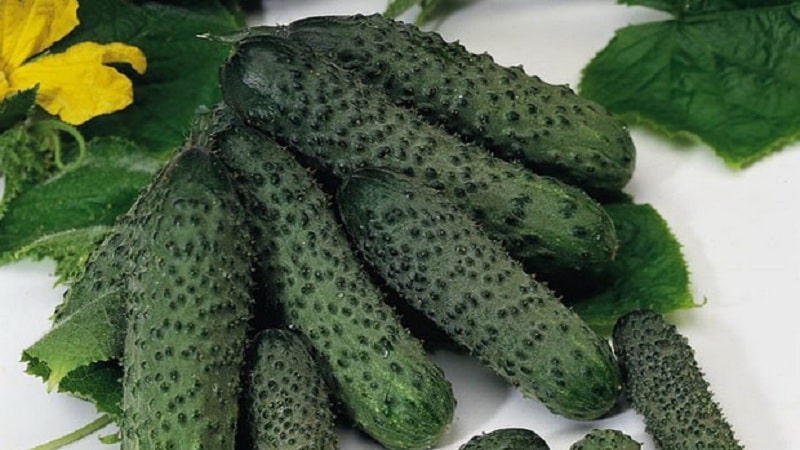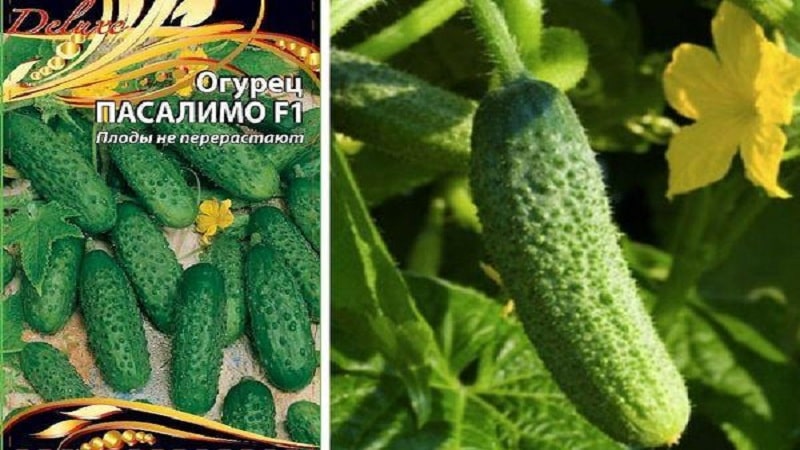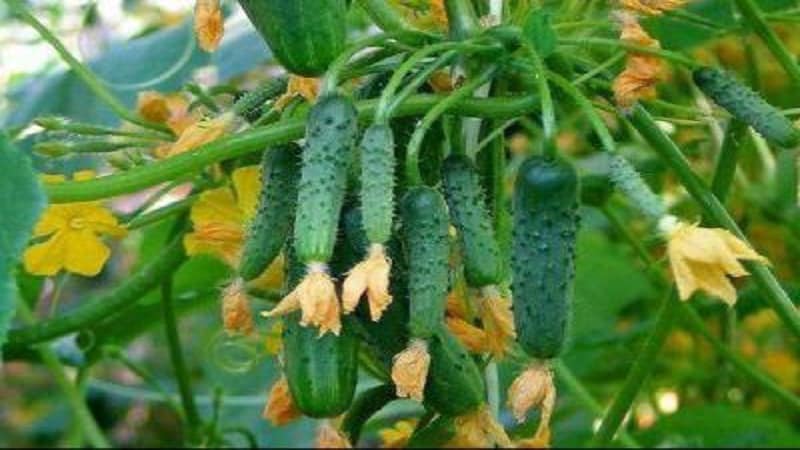What is good about the Pasalimo f1 cucumber hybrid and why it’s worth trying to grow it
Cucumber Pasalimo f1 is an early-ripening Dutch hybrid, suitable for cultivation throughout Russia. The crop has a long fruiting period, and with proper shaping of the bushes it guarantees a double harvest. The emerald dense skin with a large number of tubercles and crispy pulp without voids allows you to use pickles and gherkins for preparing winter preparations.
The culture has won the love of farmers due to its high productivity with minimal labor costs and financial investments. In this article we will talk about the pros and cons of the hybrid, the features of agricultural technology, and methods of combating the usual mosaic of cucumbers and insects.
Description of the hybrid
The Pasalimo f1 cucumber was bred by biologists from the Dutch company Syngeta seeds. The hybrid was included in the State Register of the Russian Federation in 2005. The culture is intended for cultivation in open and closed ground.
It is characterized by early ripening and has a female type of flowering. The bushes are medium-sized, powerful, with unlimited growth of the main stem. The fruits are gherkin type. From 3 to 6 greens are formed in one node.
Pictured are Pasalimo cucumbers.

Distinctive features are presented in the table:
| Indicators | Characteristic |
| Ripening period | 39-41 days |
| Pollination type | Parthenocarpic |
| Weight | 80-90 g |
| Length | 5-8 cm |
| Form | Cylindrical |
| Coloring | Dark green with short stripes, slight spotting |
| Leaves | Medium size, light green color |
| Pulp | Thick, crispy, juicy |
| Taste | Refreshing, no bitterness |
| Skin | Dense, coarsely tuberous, with white edges |
| Purpose | Universal |
| Productivity | 14 kg/m² |
| Sustainability | To olive spot, powdery mildew. |
| Transportability | High |
Chemical composition, calorie content and benefits
The calorie content of cucumbers is only 14 kcal per 100 g.
Chemical composition of the product:
- vitamins A, B1, B2, B4, B5, B6, B9, C, E, H, K, PP and beta-carotene;
- minerals: potassium, calcium, silicon, magnesium, sodium, phosphorus, iron, iodine, copper, selenium, fluorine, zinc.
Regular consumption of cucumbers has a positive effect on the body:
- normalization of water-salt balance;
- acceleration of metabolism;
- vasodilation;
- normalization of blood pressure;
- breakdown of cholesterol plaques;
- dissolution of stones and sand in the kidneys;
- normalization of the pancreas;
- improvement of blood counts.
Hybrid agricultural technology
Pasalimo f1 cucumbers are grown through direct sowing into the ground in early May, through seedlings - in early April.
Agricultural technology for cucumbers is standard. The crop needs proper watering depending on weather conditions, loosening and weeding of the soil, fertilizing with organic matter and minerals, and shaping the bushes.
Planting by seed

Cucumbers love warmth, so direct sowing is done in early May. The soil temperature should be +15-18°C, the air temperature should be stable +20°C during the day and +15°C at night.
The site for sowing is chosen on the south side. In autumn, the soil is dug up and fertilized with humus (10 liters per 1 m²). In the spring, loosen and feed with chicken droppings (10 liters per 1 m²). Sawdust and peat are mixed into the soil.
Seeds are planted in holes to a depth of 2-3 cm, with an interval of 20 cm. The distance between rows is 70 cm.The beds are watered with warm water and covered with agrofibre to protect them from frost.
Growing seedlings
The culture is characterized by early fruiting, so seeds are sown for seedlings at the end of April.
The seedling method significantly shortens the ripening period. In unprotected soil, the harvest is harvested 14 days earlier than cucumbers grown in a greenhouse.
Hybrid seeds do not require pre-sowing disinfection or treatment with germination stimulants. The material undergoes pre-treatment before packaging.
Main stages of cultivation:
- The soil mixture for growing seedlings is prepared from one part river sand, two parts peat and compost. Add 45 g of nitrophoska and 30 g of wood ash to a 10-liter bucket. The mixture is stirred, heated in the oven at a temperature of 110 ° C, then moistened, and placed in 0.5 liter peat containers.
- Seeds are planted to a depth of 2 cm, 2 pieces each. Water with warm water and stretch polyethylene on top to create a greenhouse effect.
- After the real leaves appear, the film is removed and the seedlings are placed on a sunny windowsill. The sprouts are fed with a solution: 25 g of nitrophoska per 3 liters of warm clean water.
- Seedlings are watered once a week.
- A week before planting, the seedlings are taken out into the fresh air to harden and quickly adapt to new conditions.
- After 20-25 days, the seedlings are planted in a permanent place. The holes are dug according to a 50x60 cm pattern. The seedlings are planted in holes 10 cm deep.
- The soil is covered with hay, straw, sawdust, and pine needles to retain moisture and reduce the frequency of loosening and weeding.
Growing and care
Cucumbers prefer loose and nutritious soil with a neutral pH = 7. The best crop predecessors are dill, parsley, legumes, cabbage, onions, and garlic.
Rules for successful agricultural technology:
- Loosening the soil after watering and weeding.
- In dry weather and during active fruiting, plants are watered strictly at the root every day. In cold and rainy weather, watering is stopped for a while - hypothermia of the roots leads to bacterial infections.
- The crop is fed with organic and mineral fertilizers, alternating each of them. In total, up to five portions of fertilizer are applied twice a month.
Feeding scheme:
- 10 days after planting - 10 g of urea, 10 g of superphosphate, 20 g of sodium humate per 10 liters of water;
- during the flowering and fruiting period - 25 g of nitrophoska, 20 g of chicken manure per 10 liters of water;
- subsequent feeding - 10 g of potassium sulfate, 500 ml of cow manure per 10 liters.
To improve the composition of the soil, accelerate plant growth, and increase immunity, yeast fertilizers are used: 500 g of rye bread, 500 g of tops or nettles, 500 g of pressed yeast, pour 10 liters of warm water and leave for 48 hours. The product is poured under the root.
Ready-made humic fertilizers are popular: “Breadwinner”, “Bud”, “Ideal”, “Fertika Lux”, “Zdraven”, “Fertility”.
Features of cultivation and possible difficulties
To achieve maximum productivity of the Pasalimo f1 hybrid, the bushes are molded:
- The main lash is pinched after 5-6 leaves. This stimulates the growth of additional shoots, on which the bulk of the fruits are formed.
- Side shoots are pinched over 2-3 leaves.
- Flowers and side shoots up to 6 leaves are removed.
- The lower leaves are trimmed as the bush grows to improve ventilation.
- Shoots that have given up the entire harvest are removed to stimulate new ovaries.
When properly shaped, cucumber bushes bear fruit before frost.
Pasalimo is an indeterminate hybrid with unlimited growth of the main stem, so it needs to be tied to a trellis. The manipulation is carried out after the appearance of 5-6 leaves.
Diseases and pests
The culture is immune to olive spot and powdery mildew, partially tolerant to the common virus mosaics.
Signs of this disease rarely appear at the seedling stage.
Infection is recognized during the period of active plant growth:
- mottling on leaves;
- deformation and curling of leaves with edges down;
- delayed growth of bushes;
- yellow specks and bumps on the fruit.
The main carrier of the tobacco mosaic virus is melon aphid.
Fighting methods:
- weeding with complete destruction of weeds;
- cleaning of plant residues in the off-season;
- use of sterile instruments when working with cucumber plantings;
- soil treatment with copper sulfate (50 g of substance per 10 liters of water);
- control of aphids on the site;
- treatment with a 3% solution of the drug “Farmayod-3”.
Fight aphids help:
- insecticides “Tanrek”, “Danadim”, “Decis”, “Confidor”;
- biological products “Bitoxibacillin”, “Aktofit”, “Fitoverm”, “Entobacterin”.
At the same time, they are fighting ants, because they are the ones who bring aphids to the site. To repel insects, use the Anteater product, pour boiling water over the anthills, and frequently loosen the soil.
Advice. Sow anise, oregano, marigolds, daisies, and caraway next to cucumber plantings to attract ladybugs - faithful helpers in the fight against melon aphids.
In addition to aphids, spider mites love to feast on the juicy leaves of cucumbers. In this case, folk remedies will come to the rescue:
- Pour 30 g of crushed dry dandelion roots into 1 liter of water and leave for three hours. Spray cucumbers twice a week.
- Pour 10 liters of water over the root of the hogweed, collected before flowering. After a day, treat the bushes.
- 100 g of dried datura leaves pour 1 liter of warm water. After 12 hours, strain and process the bushes.
- Fill the bucket halfway with dry marigold flowers and add warm water. Leave for 48 hours, strain and dissolve 50 g of laundry soap shavings in the infusion. Treat the bushes in the evening in dry weather, once a week.
Cucumber plantings are often attacked by slugs. To get rid of the pest, they carry out manual collection at night, irrigate the bushes with a solution of ammonia (2 tablespoons per 1 liter of water), sprinkle the beds with eggshells, tobacco shag, pine needles, and hot pepper.
Harvesting and application
The first harvest is harvested approximately 40 days after entry. Cucumbers grow in bunches, and scissors are used to carefully remove ripe specimens.
Greens are not prone to overgrowing, but frequent harvesting stimulates the growth of subsequent fruits.
The hybrid is suitable for collecting pickles measuring 3-5 cm for pickling and pickling, gherkins 5-8 cm long. The fruits are equally good in fresh and canned form.
Cucumbers tolerate transportation well over long distances without losing their presentation. Stored in a cool place for up to three weeks.
Advantages and disadvantages
Advantages of a hybrid:
- evenness of cucumbers;
- keeping quality;
- early ripeness;
- abundant fruiting before frost;
- ease of care;
- universal use in cooking;
- resistance to olive spot and powdery mildew;
- the opportunity to collect pickles and gherkins;
- excellent taste;
- lack of bitterness;
- dense, crispy flesh without voids.
The disadvantage is the need to mold the bushes.

Reviews
The Dutch hybrid is highly valued by gardeners for its high productivity with minimal labor costs. Consumers love small, crunchy cucumbers that stay fresh for a long time.
Eduard, village Rzhaksa: "I plant Pasalimo cucumbers in the greenhouse through seedlings. The seeds have excellent germination and do not require additional processing. I form the bushes into one stem and get two harvests per season. Cucumbers are dense, with a tough skin, but tasty and aromatic. I use it for pickling and marinate in vinegar.”
Maria, Lgov: “I first purchased Pasalimo’s hybrid seeds last year. I planted several bushes in the garden for testing. The culture loves water and sunlight. If there is a lack of light, it does not set fruit well. For fertilizing, I use ready-made humic fertilizers, do weeding and remove weeds.”
Conclusion
Pasalimo is a parthenocarpic hybrid of the gherkin type. Short, aligned fruits are suitable for harvesting at the stage of milky ripeness. These are often used to make savory pickled snacks.
Agricultural technology is not difficult even for novice gardeners. Like any other Dutch hybrid, Pasalimo requires frequent watering during fruiting and the application of mineral and organic fertilizers.
The plant is resistant to olive spot and powdery mildew, but is susceptible to common cucumber mosaic. Removing weeds from the site, disinfecting the soil, and killing aphids will help cope with the disease.
What kind of intellectually bankrupt people copy such crazy recommendations from one site to another: “The main lash is pinched after 5-6 leaves.This stimulates the growth of additional shoots, on which the bulk of the fruits are formed.
…..
Flowers and side shoots up to the 6th leaf are removed.”
Yes, after implementing such “recommendations” there can be no talk of any harvest at all, because the result is a stem with six leaves or more “Research Institute of Chemical Fertilizers and Pesticides” (Abr.)!!!